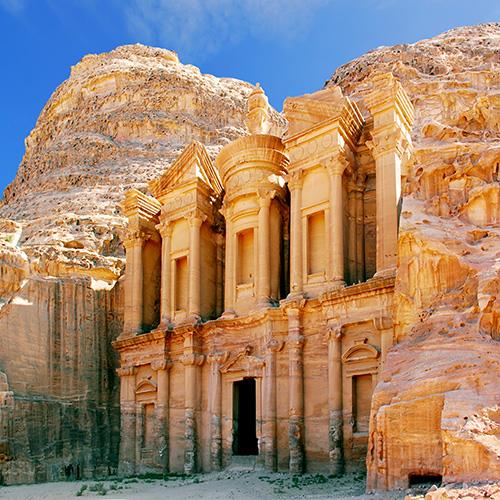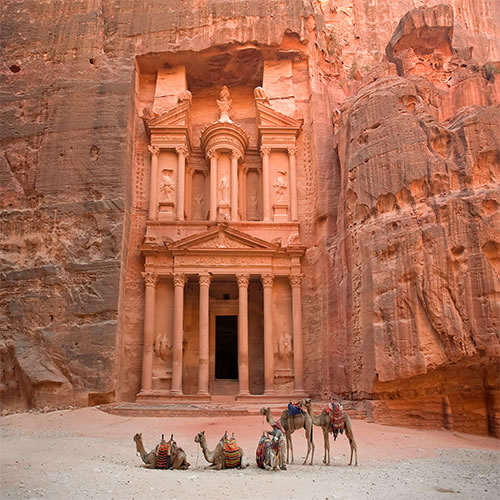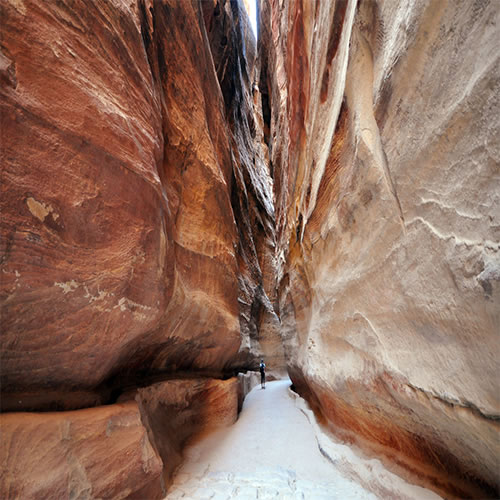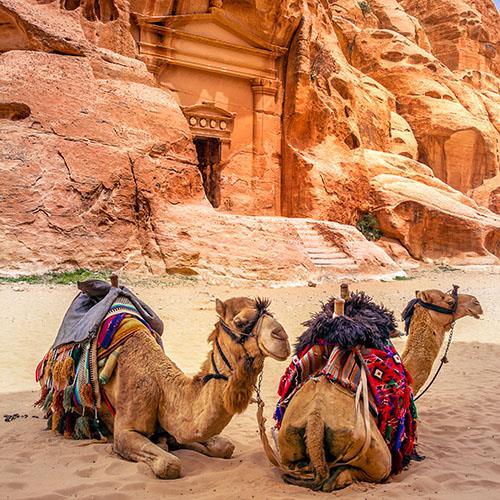Experience Petra


Overview
The Ancient City of Petra is a UNESCO World Heritage Site and one of the Seven Wonders of the Modern World, it is Jordan’s most valuable treasure. An awe-inspiring, unique, vast city and famous archeological site carved into the sheer sandstone rocks in the southwestern desert dating back to around 300 B.C. The ancient capital was a center for trade due to its location along the ancient trade routes between Arabia, Egypt, and the Mediterranean Sea. It became very wealthy and powerful and was once a bustling city filled with life and decorated with ornate houses, lush verdant gardens, and vibrant markets selling exotic goods.
Petra today is filled with the remains of massive ancient tombs and temples carved into pink sandstone cliffs nicknamed the “Rose City”, it can be accessed via a narrow canyon called Al Siq. Al Khazneh is one of the most famous structures in Petra, a 147-foot tall temple with an ornate, Greek-style facade, known as the Treasury. Exploring Petra is enlightening and incredibly interesting, it was the capital of the Nabataean Empire from the 1st century B.C. and grew rich through trade in frankincense, myrrh, and spices. A magnificent world wonder where ancient Eastern traditions join together with awe-inspiring Hellenistic architecture.





Things to See and Do
Explore Petra on foot, and begin walking through the winding sandstone canyon of the Siq, which is the gateway to this amazing archaeological site. Walk through the 1.24-mile Siq between split rocks rising 262 feet on both sides.
Explore the awe-inspiring Treasury (Al Khazneh in Arabic) with its spectacular 131-foot tall façade intricately decorated with Corinthian capitals, friezes, and figures. A giant urn stands at the top of the Treasury structure and is rumored to contain a Pharaoh`s hidden treasure. The structure was constructed during the 1st Century BC consisting of two floors with three chambers with the elaborate façade carved out of the simply stunning sandstone mountains.
Visit the Royal Tombs, which are reached by a series of steps ascending from the valley. The collections of tombs are made up of The Palace, The Corinthian, The Silk, and The Urn tombs, all of which are magnificent sites. Each tomb has its own unique characteristics and history. The Silk Tomb, for example, is named for its stunning colorful sandstone swirls of pink, white, and yellow that stand out on the façade.
See the spectacular Roman Theatre carved into the mountainside at the base of the High Place of Sacrifice. This massive theatre consists of 3 horizontal sections of seats divided by passageways. The theatre can hold more than 8,500 spectators and was built over 2,000 years ago by the Nabataeans.
Head further up the mountainside to The High Place of Sacrifice which sits at the top of Jabal Madhbah providing breathtaking views of Petra and the surrounding areas. There is a steep climb to reach the top via some stairs but the views are definitely worth it. Continue wandering the colonnaded streets through the maze of temples and tombs.
Hike up the 800 stairs (2 ½ miles) to reach the magnificent Monastery. This impressive monument stands on the hilltop and is the largest building in the city. The Monastery was built during the 3rd Century BC, carved out of the mountainside.
Head out to the mountainous desert region of Wadi Musa to the archaeological site of Little Petra also known as Siq al-Barid (Cold Canyon). This ancient area stands at 3,410 feet above sea level in the desert. The magnificent buildings here are carved into the sandstone canyons of the Petra Archeological Park a UNESCO World Heritage Site. Take the stairs that lead up to the charming Painted House with intricate paintings on the ceiling including a winged cupid with a bow and arrow. There is a narrow gorge just like the entrance to the ancient city of Petra as well as tombs, storage houses, and residences.
Take an invigorating hike and visit The Tomb of Aaron or the Shrine of Aaron that sits atop Jebel Haroun. It is the tallest point in the ancient city of Petra, a 13th-century shrine built to commemorate the death of Moses' older brother. A white dome sits at the top of the shrine and there is a small church and the tomb of Aaron. This is one of the most important religious sites in the country. A hike to the top can take 2-3 hours to complete.
Visit the Al Yakhor Turkish Bath for a relaxing afternoon of pampering and spa treatments. The local baths or `hammam` offer saunas, massages, scrubs, and hot baths to relax and revive your tired muscles.
Head out to Wadi Rum the `Valley of the Moon` and explore the protected region filled with mountains, dunes, and canyons. This area was where TE Lawrence who was known as `Lawrence of Arabia` fought alongside the Bedouin locals in WWI.
Visit the Dead Sea which is the lowest point on the earth at 1,312 feet below sea level where you can float effortlessly in the water that is filled with high levels of salt and minerals.

Shopping
There are local stalls inside the ancient city that sell water, tea, coffee, and some other items like scarves, jewelry, and antique coins. Bottles of decorative sand art are popular items to purchase as the sand comes from the rock walls within Petra, some of the artists selling these can write names in the sand inside the bottle, they are a unique memoir to take home.
The towns of Petra and Waid Musa are good places to shop for traditional Jordanian and Nabatean handicrafts where you can purchase pottery, silverware, stone carvings, and embroidery.

Cuisine
Arabic cuisine consists of a few basic groups which include meat dishes featuring lamb, chicken, or beef, never pork. A popular local tasty dish is `Shwarma` which is cooked lamb in a special sauce that is rolled in a piece of flatbread along with falafel, hummus and ful, cucumbers tomatoes, and the zingy tzatziki sauce. The food in Amman offers a lot of diversity due to its strategic position at the crossroads between the Mediterranean, the Middle East, and North Africa, and positioned with the Levant. Generally, Arabic food consists of several general basic groups.
Meat dishes with lamb, or chicken, beef is a rare option, and pork is never offered. Shwarmas. Rice and flatbread are typical sides for most meals. Chick pea-based foods are very popular such as falafel, hummus, and fuul. Baklava is a popular sweet dish, as well as knafeh nabelseyyeh, a cheese pastry and syrup dish which originates from the Palestinian city of Nables. The city is brimming with coffee shops on every corner selling delicious fresh hot Turkish coffee and fresh pastries.

Nightlife
Evening time at the ancient city allows visitors to partake in the `Petra by Night` tour. Visitors will be guided through the park at night with some sights lit up by thousands of candles. They can enjoy dinner at the only restaurant on site “The Basin”, offering a full menu of local cuisine as well as a buffet. The Petra by Night tour begins at 8:30 pm on Monday, Wednesday, and Friday evenings and includes live music and stories of the history of Petra.
Seeing the city and surrounding area lit up by the sunset is a spectacular sight. You can witness the changing colors of the sandstone as the sunlight reflects off them and the mountains. There are a few bars located in Wadi Musa including the Cave Bar, which is the oldest bar in the entire world.